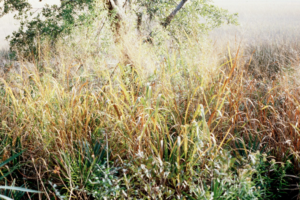Pollinator gardens are the current craze, and rightly so! Pollinators of all shapes and sizes are desperately in need of good quality habitat. But it’s not all beautiful butterflies and buzzing bees – there are predator insects on the loose, patrolling your flowerbed for their next meal. These helpful arthropods can reduce the weeds in your garden and put a stop to those leaf eating larvae. Inviting certain predator insects to your yard can benefit your flowers and keep your little slice of the ecosystem in balance. Following are a few ways to start a predator garden and how it can benefit the rest of your landscape.
Beetle Banks

Photo from http://www.projectnoah.org/spottings/995056020.
The Pennsylvania ground beetle (Harpalus pennsylcanica) is found all over North America. It feeds on the seeds of ragweed and giant foxtail as well as the larvae of Colorado potato borer. What more could you want?
A great way to start a predator garden is by creating ‘beetle banks’. We all love the aphid eating lady beetle, but there are thousands of less charismatic species to be thankful for as well. Ground dwelling beetles can be a gardeners best friend by eating weed seeds, preying on slugs, snails, mites, and much more. You might not see them in action since many species are nocturnal. Planting raised berms/mounds of clump and tuft forming grasses such as Panicum, Tripsacum, or Sprobolous, invites ground-dwelling beetles to stick around. The uncut grasses keep them cozy during winter and the raised area helps keep them dry. I learned all about this technique at a Xerxes Society training day for farmers interested in beneficial insects. Beetle banks are being tested on the agricultural scale, but it works on the small scale too.

While this Panicum virgatum planting is wild and natural looking, a few clumps of an upright variety in your garden can be beneficial and still look groomed. Wikicommons public domain image at https://commons.wikimedia.org/wiki/File%3AUSDA_switchgrass.jpg
Don’t Swat the Wasps
Your first instinct might be to knock down that wasp nest, but not so fast! Wasps are excellent predators who can rid your garden of hornworms, army worms, flies and crickets. Paper wasps and yellow jackets will package up the remains of these little pests and feed them to their young. Some wasps are so small they resemble a fly or mosquito, and these are likely a species of parasitoid wasp. These helpful friends lay their eggs inside tomato hornworms and aphids, immobilizing and eventually killing them. In fact, the University of Maryland extension called parasitoid wasps “the single most important biological control method gardeners have”. Adult wasps of all kinds mostly feed on nectar and can easily be attracted the same way as any other pollinator – by having season long nectar available in your native flower bed. Just be careful not to get too close to their nest, we all know how a wasp sting can smart!
Above, a paper wasp (Poliste fuscatus) feeds on horsetail milkweed nectar/pollen.
A Home For All Seasons
Depending on the size of garden/field you are trying to pest control, it can take years to establish a reliable predator population. Pollen/nectar producing flowers are the first part of attracting these helpers, but creating habitat is crucial to keeping them around. Along with beetle banks, blooming hedgerows or shrubby borders will provide summer nectar and winter shelter. Leaving your garden uncut through winter will make sure there are plenty of pithy stems where insects can overwinter. Reduce the amount of tilling every year to ensure that ground dwelling beetle populations aren’t decimated. And lastly, try to avoid the use of prophylactic pesticides such as treated seeds or broadcast/non-selective application. This will also kill the non-target species, such as the predator insects that might save you the cost of pesticide next season!
